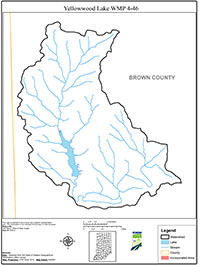Summary
The Yellowwood Lake watershed is located in south-central Indiana, approximately ten miles east of Bloomington. Included in the larger Salt Creek and East Fork White River Watersheds, the Yellowwood Lake Watershed comprises 60% of the 14-digit North Fork Salt Creek-Jackson Creek Watershed, spans approximately 4,410 acres, and is entirely contained within Brown County. In 2004, Yellowwood Lake, a 133 acre reservoir, was included on Indiana’s 303(d) list of Impaired Waterbodies for Mercury.
Unique among many small watersheds in Indiana, approximately 80% of the Yellowwood Lake watershed is publicly owned and operated by the Indiana Department of Natural Resources Division of Forestry as Yellowwood State Forest. Located within the biologically rich Brown County Hills Region, the watershed’s heavily forested (90% of total acreage) landscape and deeply dissected topography attract an estimated 200,000 people each year who come to camp, boat, hike, fish, hunt, ride horses, and enjoy nature. Other pursuits within the watershed include timber harvesting on state and private land, residential development, and private equestrian facilities.
The Yellowwood Lake Watershed Management Plan: Protecting, Enhancing, and Conserving Yellowwood Lake and Its Watershed is the result of 22 months of gathering input, conducting research, and initiating discussions among state and local government representatives, university researchers, consultants, environmentalists, watershed residents, stakeholder groups, and concerned citizens in order to identify and address watershed concerns. The Yellowwood Lake Watershed Planning Group (YLWPG), formed in 2000, led the process of developing this watershed management plan.
This plan was developed as a result of the group’s efforts to protect, enhance, and conserve the ecological health of Yellowwood Lake and its watershed. To accomplish this goal, the YLWPG focused its attention on three main areas in the watershed:
- sedimentation
- nuisance and invasive species, and
- biological and chemical contamination.
A fourth concern, group sustainability, arose as the group discussed implementation of this plan. The YLWPG conducted water quality investigations to develop problem statements, goals, objectives, and action items to address each of the four focus topics.

